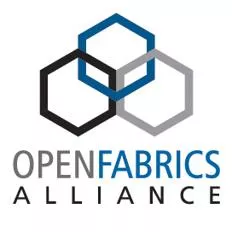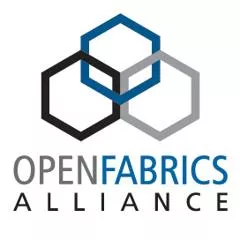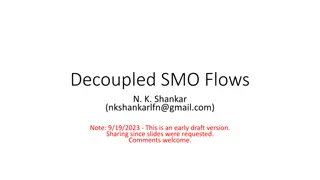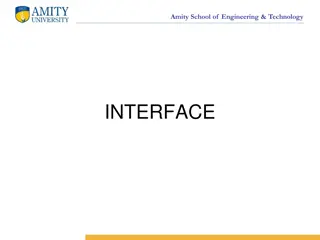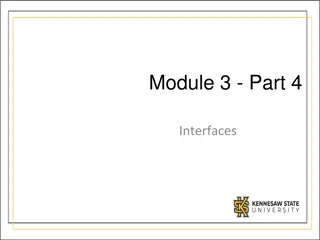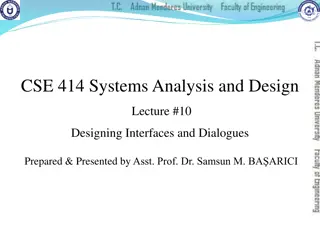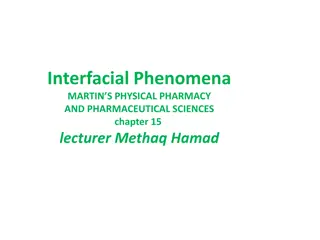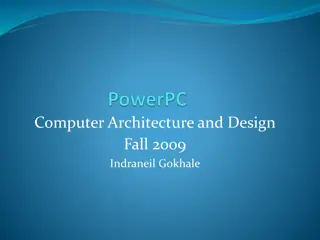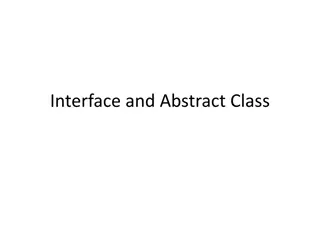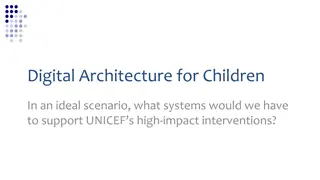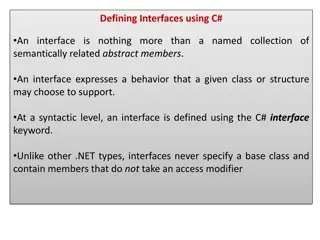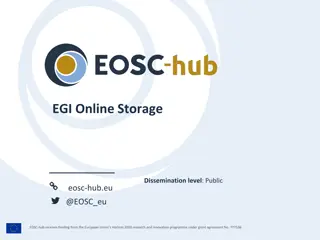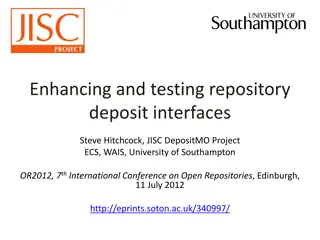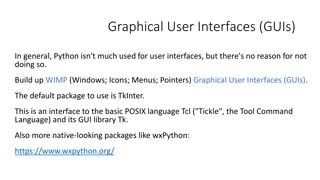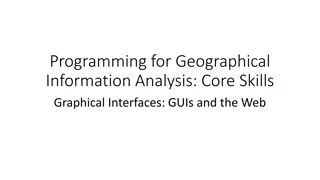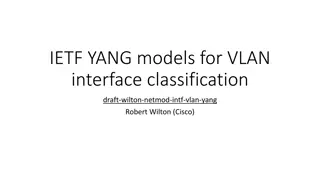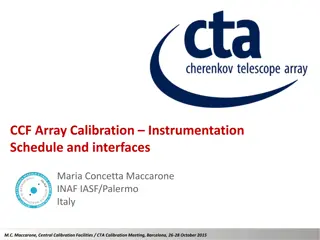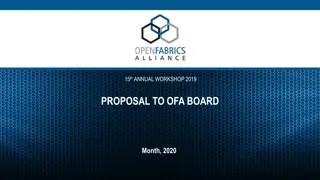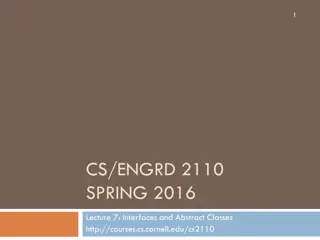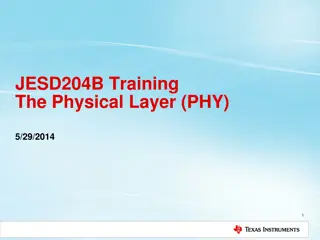Evolution of OpenFabrics Interfaces Architecture
Evolution of OpenFabrics Interfaces Architecture aims to align software interfaces with application requirements in the realm of high-performance computing (HPC). With a focus on supporting multiple interface semantics, remaining fabric and vendor agnostic, and adaptable in upstream Linux, the initiative seeks to address the evolving landscape of HPC hardware and fabric features. By leveraging the open source community, engaging with active developers and vendors, optimizing software APIs for available hardware features, and supporting multiple product generations, the project drives towards creating a more efficient and agile framework for high-performance fabric services. The OFIWG Charter outlines the development of an extensible, open-source framework and interfaces that cater to ULP and application needs for high-performance fabric services while minimizing impedance between ULPs and network APIs. The invitation for participation signals an open engagement for interested parties to contribute towards driving software design aligned with workload requirements.
Download Presentation

Please find below an Image/Link to download the presentation.
The content on the website is provided AS IS for your information and personal use only. It may not be sold, licensed, or shared on other websites without obtaining consent from the author.If you encounter any issues during the download, it is possible that the publisher has removed the file from their server.
You are allowed to download the files provided on this website for personal or commercial use, subject to the condition that they are used lawfully. All files are the property of their respective owners.
The content on the website is provided AS IS for your information and personal use only. It may not be sold, licensed, or shared on other websites without obtaining consent from the author.
E N D
Presentation Transcript
Open Fabrics Interfaces Architecture Introduction Sean Hefty Intel Corporation
Current State of Affairs OFED software Widely adopted low-level RDMA API Ships with upstream Linux but OFED SW was not designed around HPC Hardware and fabric features are changing Divergence is driving competing APIs Interfaces are being extended, and new APIs introduced Long delay in adoption Size of clusters and single node core counts greatly increasing More applications are wanting to take advantage of high- performance fabrics 2
Solution Evolve OpenFabrics Design software interfaces that are aligned with application requirements Target needs of HPC Support multiple interface semantics Fabric and vendor agnostic Supportable in upstream Linux 3
Enabling through OpenFabrics Leveraging existing open source community Broad ecosystem Application developers and vendors Active community engagement Drive high-performance software APIs Take advantage of available hardware features Support multiple product generations Open Fabrics Interfaces Working Group 4
OFIWG Charter Develop an extensible, open source framework and interfaces aligned with ULP and application needs for high-performancefabric services Software leading hardware Enable future hardware features Minimal impact to applications Minimize impedance match between ULPs and network APIs Craft optimal APIs Detailed analysis on MPI, SHMEM, and other PGAS languages Focus on other applications storage, databases, 5
Call for Participation OFI WG is open participation Contact the ofiwg mail list for meeting details ofiwg@lists.openfabrics.org Source code available through github github.com/ofiwg Presentations / meeting minutes available from OFA download directory Help OFI WG understand workload requirements and drive software design 6
Enable.. Scalability High performance Optimized software path to hardware Reduced cache and memory footprint Independent of hardware interface, version, features Scalable address resolution and storage Tight data structures Extensible App-centric More agile development Analyze application needs Time-boxed, iterative development Application focused APIs Adaptable Implement them in a coherent, concise, high-performance manner 7
Verbs Semantic Mismatch Current RDMA APIs Evolved Fabric Interfaces 50-60 lines of C-code 25-30 lines of C-code Reduce setup cost - Tighter data Allocate WR Allocate SGE Format SGE 3 writes Format WR 6 writes Direct call 3 writes optimized send call Checks 2 branches generic send call Eliminate loops and branches - Remaining branches predictable Loop 1 Checks 3 branches Checks 9 branches Loop 2 Check Loop 3 Checks 3 branches Selective optimization paths to HW - Manual function expansion 8
Application-Centric Interfaces Reducing instruction count requires a better application impedance match Collect application requirements Identify common, fast path usage models Too many use cases to optimize them all Build primitives around fabric services Not device specific interface 9
OFA Software Evolution Verbs CM Fabric Interfaces libfabric RDMA CM IB Verbs FI Provider uVerbs Command Verbs Provider Transition from disjoint APIs to a cohesive set of fabric interfaces 10
Fabric Interfaces Framework Focus on longer-lived interfaces software leading hardware Take growth into consideration Reduce effort to incorporate new application features Addition of new interfaces, structures, or fields Modification of existing functions Allow time to design new interfaces correctly Support prototyping interfaces prior to integration 11 www.openfabrics.org
Fabric Interfaces Framework defines multiple interfaces Fabric Interfaces Control Interface Message Queue Atomics RMA Triggered Operations Addressing Services Tag CM Services Matching Fabric Provider Implementation Control Interface Message Queue Atomics RMA Triggered Operations Addressing Services Tag CM Services Matching Vendors provide optimized implementations 12
Fabric Interfaces Defines philosophy for interfaces and extensions Focus interfaces on the semantics and services offered by the hardware and not the hardware implementation Exports a minimal API Control interface Defines fabric interfaces API sets for specific functionality Defines core object model Object-oriented design, but C-interfaces 13
Fabric Interfaces Architecture Based on object-oriented programming concepts Derived objects define interfaces New interfaces exposed Define behavior of inherited interfaces Optimize implementation 14 www.openfabrics.org
Control Interfaces fi_getinfo Application specifies desired functionality Discover fabric providers and services Identify resources and addressing fi_getinfo fi_fabric fi_fabric FI Framework Open a set of fabric interfaces and resources fi_register fi_register Dynamic providers publish control interfaces 15 www.openfabrics.org
Application Semantics Get / set using control interfaces Progress Application or hardware driven Data versus control interfaces Ordering Message ordering Data delivery order Multi-threading and locking model Compile and run-time options 16 www.openfabrics.org
Fabric Object Model Software objects usable across multiple HW providers Fabric Interfaces Boundary of resource sharing Fabric Event Queue Passive Endpoint Resource Domain Event Queue Resource Domain Event Queue Active Endpoint Active Endpoint Address Vectors Event Counter Address Vectors Event Counter Provider abstracts multiple NICs NIC NIC NIC Physical Fabric 17 www.openfabrics.org
Endpoint Interfaces Communication interfaces Interfaces Properties CM Type Message Transfers RMA Tagged Atomics Triggered Endpoint Capabilities Protocol Software path to hardware optimized based on endpoint properties Message Transfers RMA Tagged Atomics Triggered Aliasing supports multiple software paths to hardware 18 www.openfabrics.org
Application Configured Interfaces Communication type App specifies comm model Provider directs app to best API sets Capabilities Endpoint Data transfer flags sm. msg lg. msg RMA write send inline send read RMA Ops Message Queue Ops NIC 19
Event Queues Asynchronous event reporting Interface Details Context only Data Tagged Generic Properties Compact optimized data structures Format Event Queues Domain None fd mwait Wait Object User specified wait object Optimize interface around reporting successful operations Event counters support lightweight event reporting 20 www.openfabrics.org
Event Queues App selects completion structure Generic completion Op context read CQ optimized CQ +1 write, +0 branches Application optimized completion Send: +4-6 writes, +2 branches Recv: +10-13 writes, +4 branches Generic verbs completion example 21 www.openfabrics.org
Address Vectors Fabric specific addressing requirements Store addresses/host names - Insert range of addresses with single call Share between processes Example only Reference entries by handle or index - Handle may be encoded fabric address Reference vector for group communication Start Range End Range Base LID SL host10 host1000 50 1 host1001 host4999 2000 2 Enable provider optimization techniques - Greatly reduce storage requirements 22
Summary These concepts are necessary, not revolutionary Communication addressing, optimized data transfers, app- centric interfaces, future looking Want a solution where the pieces fit tightly together 23 www.openfabrics.org
Repeated Call for Participation Co-chair (sean.hefty@intel.com) Meets Tuesdays from 9-10 PST / 12-1 EST Links Mailing list subscription http://lists.openfabrics.org/mailman/listinfo/ofiwg Document downloads https://www.openfabrics.org/downloads/OFIWG/ libfabric source tree www.github.com/ofiwg/libfabric labfabric sample programs www.github.com/ofiwg/fabtests 24
Backup 25 www.openfabrics.org
Verbs API Mismatch Significant SW overhead Application request struct ibv_sge { uint64_t uint32_t uint32_t }; <buffer, length, context> addr; length; lkey; 3 x 8 = 24 bytes of data needed SGE + WR = 88 bytes allocated struct ibv_send_wr { uint64_t struct ibv_send_wr *next; struct ibv_sge *sg_list; int enum ibv_wr_opcode opcode; int uint32_t ... }; wr_id; Requests may be linked - next must be set to NULL num_sge; Must link to separate SGL and initialize count imm_data; send_flags; App must set and provider must switch on opcode Must clear flags 28 additional bytes initialized 26
Verbs Provider Mismatch Most often 1 (overlap operations) For each work request Check for available queue space Check SGL size Check valid opcode Check flags x 2 Check specific opcode Switch on QP type Switch on opcode Check flags For each SGE Check size Loop over length Check flags Check Check for last request Other checks x 3 Often 1 or 2 (fixed in source) Artifact of API QP type usually fixed in source Flags may be fixed or app may have taken branches 19+ branches including loops 100+ lines of C code 50-60 lines of code to HW 27
Verbs Completions Mismatch Application accessed fields struct ibv_wc { uint64_t enum ibv_wc_status status; enum ibv_wc_opcode opcode; uint32_t uint32_t uint32_t uint32_t uint32_t int uint16_t uint16_t uint8_t uint8_t }; wr_id; App must check both return code and status to determine if a request completed successfully vendor_err; byte_len; imm_data; qp_num; src_qp; wc_flags; pkey_index; slid; sl; dlid_path_bits; Provider must fill out all fields, even those ignored by the app Provider must handle all types of completions from any QP Developer must determine if fields apply to their QP Single structure is 48 bytes likely to cross cacheline boundary 28
RDMA CM Mismatch Want: reliable data transfers, zero copies to thousands of processes RDMA interfaces expose: struct rdma_route { struct rdma_addr addr; struct ibv_sa_path_rec *path_rec; ... }; Src/dst addresses stored per endpoint 456 bytes per endpoint Path record per endpoint struct rdma_cm_id {...}; rdma_create_id() rdma_resolve_addr() rdma_resolve_route() rdma_connect() Resolve single address and path at a time All to all connected model for best performance 29
Progress Ability of the underlying implementation to complete processing of an asynchronous request Need to consider ALL asynchronous requests Connections, address resolution, data transfers, event processing, completions, etc. HW/SW mix All(?) current solutions require significant software components 30 www.openfabrics.org
Progress Support two progress models Automatic and implicit Separate operations as belonging to one of two progress domains Data or control Report progress model for each domain SAMPLE Implicit Automatic Data Software Hardware offload Control Software Kernel services 31 www.openfabrics.org
Automatic Progress Implies hardware offload model Or standard kernel services / threads for control operations Once an operation is initiated, it will complete without further user intervention or calls into the API Automatic progress meets implicit model by definition 32 www.openfabrics.org
Implicit Progress Implies significant software component Occurs when reading or waiting on EQ(s) Application can use separate EQs for control and data Progress limited to objects associated with selected EQ(s) App can request automatic progress E.g. app wants to wait on native wait object Implies provider allocated threading 33 www.openfabrics.org
Ordering Applies to a single initiator endpoint performing data transfers to one target endpoint over the same data flow Data flow may be a conceptual QoS level or path through the network Separate ordering domains Completions, message, data Fenced ordering may be obtained using fi_sync operation 34 www.openfabrics.org
Completion Ordering Order in which operation completions are reported relative to their submission Unordered or ordered No defined requirement for ordered completions Default: unordered 35 www.openfabrics.org
Message Ordering Order in which message (transport) headers are processed I.e. whether transport message are received in or out of order Determined by selection of ordering bits [Read | Write | Send] After [Read | Write | Send] RAR, RAW, RAS, WAR, WAW, WAS, SAR, SAW, SAS Example: fi_order = 0 // unordered fi_order = RAR | RAW | RAS | WAW | WAS | SAW | SAS // IB/iWarp like ordering 36 www.openfabrics.org
Data Ordering Delivery order of transport data into target memory Ordering per byte-addressable location I.e. access to the same byte in memory Ordering constrained by message ordering rules Must at least have message ordering first 37 www.openfabrics.org
Data Ordering Ordering limited to message order size E.g. MTU In order data delivery if transfer <= message order size WAW, RAW, WAR sizes? Message order size = 0 No data ordering Message order size = -1 All data ordered 38 www.openfabrics.org
Other Ordering Rules Ordering to different target endpoints not defined Per message ordering semantics implemented using different data flows Data flows may be less flexible, but easier to optimize for Endpoint aliases may be configured to use different data flows 39 www.openfabrics.org
Multi-threading and Locking Support both thread safe and lockless models Compile time and run time support Run-time limited to compiled support Lockless (based on MPI model) Single single-threaded app Funneled only 1 thread calls into interfaces Serialized only 1 thread at a time calls into interfaces Thread safe Multiple multi-threaded app, with no restrictions 40 www.openfabrics.org
Buffering Support both application and network buffering Zero-copy for high-performance Network buffering for ease of use Buffering in local memory or NIC In some case, buffered transfers may be higher- performing (e.g. inline ) Registration option for local NIC access Migration to fabric managed registration Required registration for remote access Specify permissions 41 www.openfabrics.org
Scalable Transfer Interfaces Application optimized code paths based on usage model Optimize call(s) for single work request Single data buffer Still support more complex WR lists/SGL Per endpoint send/receive operations Separate RMA function calls Pre-configure data transfer flags Known before post request Select software path through provider 42




